#unbuilt architecture
Explore tagged Tumblr posts
Text

Rhododendron Chapel, unbuilt by project by Frank Lloyd Wright, 1952. John Howe, delineator
via
17 notes
·
View notes
Text
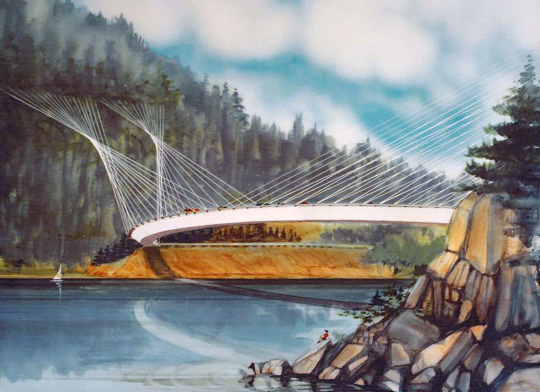
Concept art for the unbuilt Ruck-A-Chucky Bridge by architect Myron Goldsmith and engineer T.Y. Lin (1978)
6 notes
·
View notes
Text







IDEAL CITIES - NOT
Chongqing again. Here are the buildings we designed, neither of which have been built 12 years later, judging from Google Earth images from February of this year. The first was an exercise in an Art Deco influenced design which they love so much over there. It was planned to be built at a major new transit hub of crossing train and subway lines. On top of the subway station, which was very deep, there were to be several levels of an underground shopping mall. Judging from the aerial, the underground structures may be in place. The first image is our original concept, the second a later toning down.
The second project is unapologetically modern. It was to have been built near the National Theater at the junction of the two rivers, across from where Safdie's Raffles Center was built. There is a hole in the ground, waiting to be filled.
All of the unbuilt projects one has designed could populate ones own little ideal city. Maybe we will put them all together one day!
1 note
·
View note
Text







IDEAL CITIES - NOT
Chongqing again. Here are the buildings we designed, neither of which have been built 12 years later, judging from Google Earth images from February of this year. The first was an exercise in an Art Deco influenced design which they love so much over there. It was planned to be built at a major new transit hub of crossing train and subway lines. On top of the subway station, which was very deep, there were to be several levels of an underground shopping mall. Judging from the aerial, the underground structures may be in place. The first image is our original concept, the second a later toning down.
The second project is unapologetically modern. It was to have been built near the National Theater at the junction of the two rivers, across from where Safdie's Raffles Center was built. There is a hole in the ground, waiting to be filled.
All of the unbuilt projects one has designed could populate ones own little ideal city. Maybe we will put them all together one day!
1 note
·
View note
Link

http://stuffnobodycaresabout.com/2014/05/21/in-1911-the-proposed-mccarren-bridge-was-to-replace-the-old-brooklyn-bridge-while-it-was-being-reconstructed/
1 note
·
View note
Text

The first architectural rendering of the future Rockefeller Center (then called Metropolitan or Radio City) was revealed on March 6, 1931.
The press was not kind. "The crux of the problem is that Radio City is ugly," wrote the Herald Tribune. "The exterior is hideously dull and ugly." The Times referred to its "architectural fallacies and horrors." The central feature of the design, a circular structure to house Chase National Bank, was called an "oil drum."
The architects were sent back to the drawing board, with Raymond Hood now advising. He opened up the campus, which had had a lot of buildings crammed into a small space, replaced the brick with limestone, and scrapped the oil drum. He also added rooftop gardens to several buildings and placed a fountain in the sunken plaza.
Photo: istoriadelosrascacielosdenuevayork
#vintage New York#1930s#Rockefeller Center#unbuilt New York#architectural rendering#design#urban planning#Raymond Hood#March 6#6 March#architecture
66 notes
·
View notes
Text

SF Yimby, in their story on the Transamerica Pyramid, featuring an earlier design by architects William L. Pereira & Associates:
The unbuilt ABC Tower in New York early study of elevator travel times, illustration by William L Pereira & Associates courtesy the USC Library
#image#abc tower#new york#new york city#unbuilt#architecture#san francisco#transamerica pyramid#william pereira#design#blueprint#architectural drawing#skyscraper
3 notes
·
View notes
Text
The first thing you’ll notice — perhaps helped by a translation app, as tourists and monolingual English speakers are not among Familjny’s usual clientele — is that the food is outrageously cheap. Once you’ve worked out what dishes you want, you queue up to a little niche. You ask here for what you want, and you’ll be given a bit of paper. You take this to a larger niche, from which you can see the kitchen, and you give it to a uniformed staff member, who would usually be middle-aged or older. They will dollop the particular parts of your meal onto your plate. Then you sit down, and you eat it, and when you’ve finished, you put the plate and your cutlery onto a rack — there is nothing so servile as waiting staff. There are some drawbacks to this system, to be sure. I have only once or twice been in a milk bar that had a toilet, and because at lunchtime especially there are always a lot of people queueing, you are not encouraged to linger. You eat, and then you go home or back to work — but you’ll have been able to have a decent three-course meal of soup, a main course, and a slice of cake for the equivalent of, at the very most, £5, in a country where the cost of living is almost comparable to Britain’s.
[...]
In Poland, the milk bar idea has been dated by some to the late nineteenth century, when the bulk of Poland, including Warsaw, was under Tsarist Russian occupation. Milk bars would offer locally produced food to benefit Polish farmers, and there would be no alcohol to cloud the minds of Polish workers, and also, importantly, little meat, which would make the food both cheaper and healthier. But nearly every milk bar in Poland was opened between 1945 and 1989, becoming the local example of a subgenre of cheap communal eating facilities built and encouraged by state socialist governments; what distinguishes it today is the fact that it still endures, for reasons which are complicated and surprising. Communal eating was regarded as being of crucial importance by Bolshevik thinkers from the start. Partly, this was a consequence of their pioneering feminism. Both for Lenin and for explicitly liberationist thinkers like Alexandra Kollontai, one of the central tasks of the revolutionary government that seized power in October 1917 was to free working-class women from ‘kitchen slavery’, as exemplified in the St Petersburg’s textile industry, which saw women work in factories all day and then go home and cook (and clean) for their menfolk. Early plans were highly ambitious, and they were integrated with avant-garde architecture and urban design; a few remnants of this programme survive in the larger cities of Russia, and Ukraine in particular. When researching a book on Soviet architecture in the 2010s, I went looking for a few of these, and the results were often sad to behold. In St Petersburg — then Leningrad — at the end of the 1920s, a team of architects, some of whom had worked with Vladimir Tatlin on his famous unbuilt twisting tower in tribute to the Third International, were charged with designing communal kitchens in the factory districts of the city. All three of them survive, but they have been turned into dodgy nightclubs, cheap malls, or worse: the finest of the group, a fabulous, dynamic, futuristic building, in the Narvskaya Zastava district, had been subdivided into little units by, among others, McDonalds. In Moscow meanwhile, enormous Constructivist bakeries were built around the city. One of the largest of them, Bakery Plant No. 5, was turned into a museum of Constructivism in 2022; the year, that is, of Russia’s full-scale invasion of Ukraine, a vainglorious nationalist slaughter that would have horrified the socialist modernists behind these buildings. In the 1920s, housing was sometimes built in such a way as to encourage its inhabitants to eat collectively. In Moscow’s experimental Narkomfin Communal House, duplex apartments were connected by a walkway to a restaurant, a library, a nursery, and a gym, with a roof garden on top; inside the flats, kitchens were either tiny or, in the ‘fully collectivised’ apartments, absent entirely, with the assumption that you could always eat in, or take your food from, the communal restaurant. For its Constructivist architect Moisei Ginzburg, this would liberate women residents entirely from the assumption — unavoidable in the early twentieth century — that they would be cooking the dinner. But in the Stalin era, Soviet food culture became much more hierarchical. These dreams of vast avant-garde dining halls serviced by streamlined, automated processes and administered by happy class-conscious workers were replaced with, at the top, a series of luxury restaurants for the nomenklatura; at the bottom, factory canteens; and, in between, the stolovaya — a network of public dining halls across the country, expanded especially in the more egalitarian Khrushchev era, during which period modernist glass box cafes also appeared in the larger urban centres, as a return to the 1920s dreams of automated communal luxury.
17 February 2025
101 notes
·
View notes
Text
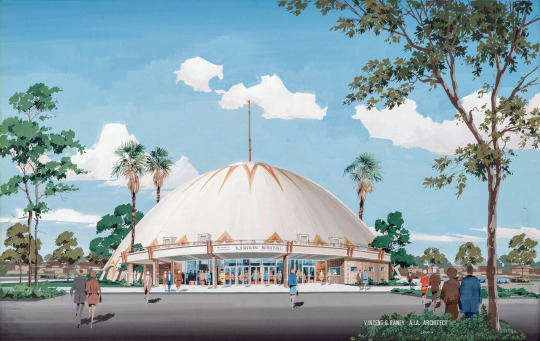
Concept for a domed cinema by architect Vincent G. Raney (1966)
via
5 notes
·
View notes
Text


A key publication on Aldo van Eyck without doubt is Francis Strauven's monograph "Aldo van Eyck - Relativiteit en Verbeelding“, published by Meulenhoff in 1994 (the English version „The Shape of Relativity“ followed in 1998). In close cooperation with Van Eyck Strauven sleuths the origins and influences of the architect's design and philosophical principles and combines them with his built and unbuilt works, his writings and personal network. The result is a behemoth of a book comprising 680 pages and predominantly focusing on Van Eyck's childhood, education and work until 1963. Strauven justifies this seemingly narrow focus with the importance of these formative years that his fundamental conceptions took shape in these years and very much culminated in his Orphanage completed in 1960. Up to this point Van Eyck had received a very international and broad education through his childhood in England, the intellectually stimulating household he came from and his architecture studies at ETH Zurich. Through the acquaintance with Carola Giedion-Welcker, Siegfried Giedion’s wife, he was also introduced to the world of contemporary art that would become a decisive influence on his world view and which ultimately led to his core conviction of relativity being the basis of 20th century culture. Francis Strauven undoubtedly is an admirer and eloquent exegete of Aldo van Eyck and his partisanship certainly also shows in the book. But through the closeness to the architect he also was able to profoundly examine and explain the work, life and intellectual cosmos of one of the 20th century's most important but somewhat underrated architects. I have read the book several times but always discover new aspects and strands of thought to reflect on, a quality only few books possess and which makes this volume a true must-read!
#aldo van eyck#architecture book#architecture#netherlands#structuralism#architectural history#book#monograph
29 notes
·
View notes
Text
11 Underexplored settings of post-apocalyptic worlds
Inspired once again by my recent binge of abandoned explorations.
The greatest hits of the sprawling city scapes and farmland that feature in everything from post-alien invasions to zombie takeovers to just worlds gone by in a not-so-distant future tend to be:
Generic office buildings
Churches
Schools
Water parks
Suburbs
Famous monuments
Cruise ships
It’s come to my attention though just how many architectural abnormalities there are, in their own current post-apocalyptic states, that would absolutely befuddle archaeologists centuries from now trying to figure out their purposes.
So whether you want to go hard into “this new world has completely forgotten what came before it” or your very own and unique road trip through desolation, here’s some suggestions for cool and/or practical settings!
1. Disney/Iconic Theme Parks
2000 years from now after X disaster strikes, survivors completely removed from historical context stumble upon…. Disney World. They presume Mickey really was a giant mutant mouse, or a mouse-shaped deity worshiped by the local populace (and I mean… are they wrong?). People who might have never left the local area without planes and feasible transport, or knowledge that land across the ocean even exists, might be astounded by the buildings of Epcot’s World Showcase, or any of Disney’s themed resorts.
Water parks are done to death, but not enough emphasis is put onto how bizarre these places would look without context, even to a younger generation that has no idea what it used to be.
Orlando has a hotel with its own rainforest in a massive atrium, with ponds and boats and boardwalks inside. But, you know, I guess strolling through Chicago or New York City is cooler. It may be unfilmable, but it’s not unwritable.
2. The foundations of unfinished construction projects
The remains of an office building that never was, a veritable modern Stonehenge with how little would survive an apocalypse. Inexplicable areas of land with massive pits for unbuilt parking garages, or sprawling swimming pools and lazy rivers.
Or massive, skeletal towers that would have been the monument to a much larger estate that just lost funding. Buildings still surrounded by scaffolding, only half-complete with their windows.
3. Survivor’s encampment landmarked by a monument/hotel/theme park that was never built
In one of those abandoned videos, a company in China was trying to build a discount Disneyland and all that remains is an unfinished Cinderella Castle with steel shells of the gables… behind a modern shopping mall.
Any structure that would have been deeply out of place either in the country it’s built in, or the newer buildings that surround it, immediately looks more creative than just ‘generic strip mall’ or ‘generic high school’. And it’s also realistic, as projects like this fall through constantly, as a unique piece of your worldbuilding. Or, it did have its run as whatever the strange building was part of, and through bankruptcy and selling the land around it, it ends up being the only structure that remains.
4. Hotels that are made up as if the staff vanished instantaneously
Or, many, many Covid victims. Having your characters scrounge for resources through a hotel with beds still made, coffee cups on the breakfast tables, serving spoons and plates ready to go by the buffet. Halloween, Christmas, or Valentine’s decorations still on display.
The schedules for the final week of business still hanging in the offices, unopened mail, packages for guests still in the mail room, pallets of new soaps and supplies still in the delivery bay from the distribution center, linens still in the industrial dryers. I worked in a hotel scheduled for eventual demolition and the disrepair the interior fell into because, what’s the point of managing mold and bed bugs when it’s all getting gutted anyway, makes it super creepy knowing guests are completely clueless on the other side.
Places that have been completely ransacked and destroyed are creepy, sure, but places that are almost frozen in time despite the decay around them are both eerie, and rather dark. Cruise ships/confined spaces like ships tend to be used more for horror, but these, too, as if they’re frozen in time.
5. Cargo ships/shipping yards
An easy-ish one to film in. Looters breaking open shipping containers, or building entire communities and homes out of those containers either on land, or on the barges and ships. A community that can weigh anchor and move once resources and scavenging dries up, or another violent group moves in on the land.
Or, in the case of a viral apocalypse, a community relatively spared from the violence out on the open ocean.
6. IKEA/Furniture Warehouses and DC’s
Warehouses especially have few entries and fewer windows to secure, but as their contents (except the showroom floor) are in mint condition at the time of the world ending and probably stored in plastic and crates, they’d be relatively spared from the elements as a good base camp.
Furniture is also too heavy to loot in a panic and absconding with a brand new mattress probably wouldn’t be at the top of people’s minds as doomsday approaches.
Your little community each having their own lavish living spaces with whatever eclectic furniture they either liked or could now get their hands on for free would just be cool to read about.
7. Penthouse suites
Climbing those stairs would suck and depending on the build quality, the safety of the structure over time would degrade, but maybe your community has manual cranks for the elevators. There might be one way down, but there’s also only one way up, and you can see invaders and catastrophe coming for miles.
These places tend to be dripping in luxury your characters might otherwise have never experienced and they could either make a base there, or have a grand old time trashing the place up because the rich are dead and gone.
8. Historical forts
They lasted this long, why not a few centuries more? The fort that comes to mind is the Castillo de San Marcos in St. Augustine, Florida, right on the beach with a built-in defense wall and a huge courtyard for your community of plucky survivors.
Castles, too, though they’d likely be prime real estate for all manner of interested parties. Aging, famous forts are just never in these types of stories, unless it’s a picture of where the military used to be, now overrun or destroyed.
9. Ski resorts
Similar to the made-up hotels and theme parks, this one comes with presumably multiple buildings, potential use of the slopes and ski transports, isolation via elevation and remoteness from major cities, and the threat of bitter winters and blizzards.
Never been to one myself in winter, but remote locations for a post-apocalypse story tends to just be shorthand for “generic farm or small town,” which isn’t super immersive.
10. Luxury malls
Seen in The Last of US, it gives you a microcosm of so many different environments all slapped together and there’s no limit on what kinds of stores you could include, or all the kiosks, all the mini attractions like trampolines, kiddie parks, massage tables, and even VR flight simulators.
Maybe it has a theater tacked onto it, or a double-story book store, one of those rental spaces dedicated to fancy cars or candy stores. Great for the main setting or even just passing through, especially as they’re already a dying breed you can go ham with. ‘Luxury’ and designer items collecting dust right across from the discount store with everything for under &14.99 could strike a powerful message about social constructs.
11. Science museums
Sure you can make some poignant message about priceless artwork being left to rot, or. When I was a kid, I went to a science center with natural disaster simulators like house fires and tornadoes and a whole-ass IMAX theater where I saw Night at the Museum, the only movie I’ve ever seen in a proper IMAX dome.
There was a whole kids section with a ropes course, area for exploring the human body, a NASA-sponsored mock up space module, mock up grocery store, and little exhibits here and there about optical illusions and the physics behind laying on a bed of nails and how it doesn’t kill you. It’s just something unique and fun that your characters can interact with and gives them plenty to play off and give little anecdotes to make them feel more human.
—
Point is, your post-apocalypse doesn’t have to be limited to the usual suspects. We’ve all seen the strip malls and Walmarts and suburban homes and farms. There is no special effects budget or filming restraint in a book and I’d love to read more stories set in unique and descriptive places, or just fresh takes on your standard survival camp that isn’t just “build a wall around a section of neighborhood”.
It’s the apocalypse. All real estate becomes free real estate.
#sci fi#fantasy#post apocalyptic#world building#worldbuilding#writing advice#writing resources#writing a book#writing tips#writing tools#writing#writeblr
115 notes
·
View notes
Text
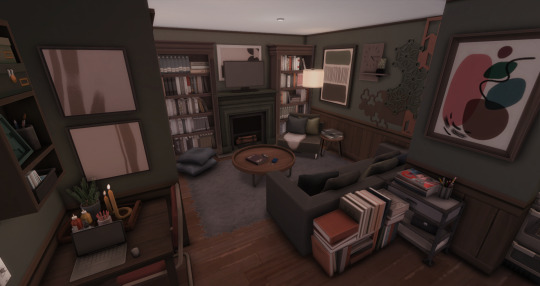
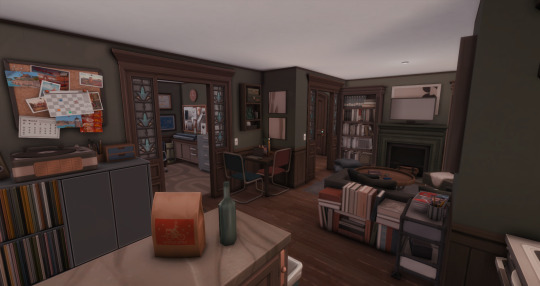
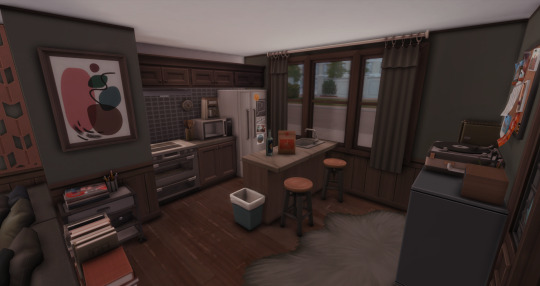
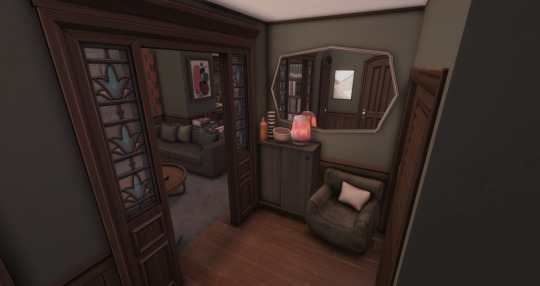
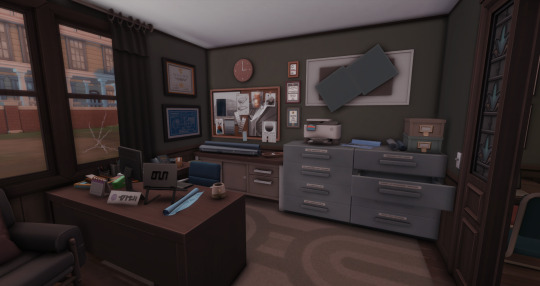


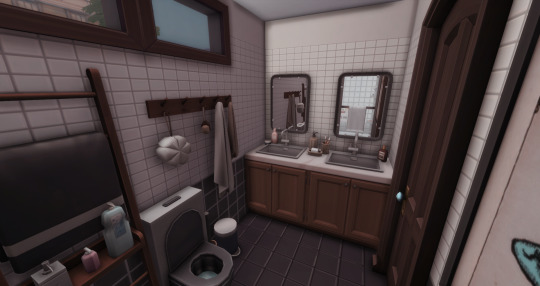

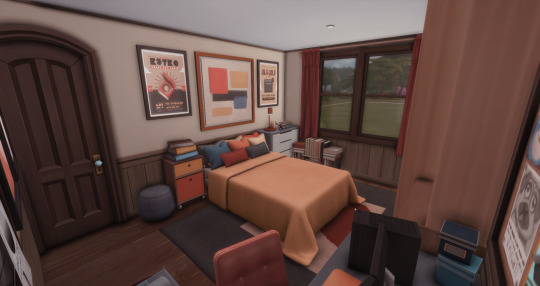

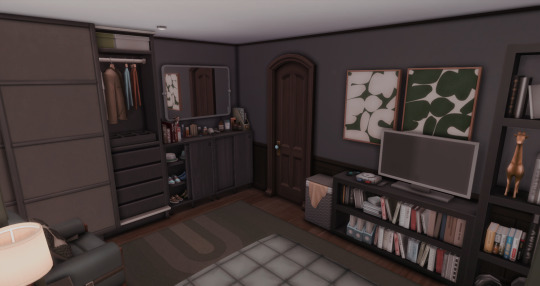
High-end two bedroom apartment
Please please please excuse the fact that you can see unbuilt normal suburbia outside the windows💀this build belongs in one of the pinecrest apartments but for whatever reason I built it on an empty lot instead.
With that aside, I'm especially pleased with the home office workspace in this one. It's very cluttered without being unusuably messy.
The architectural style is supposed to seem on the older side, with more modern decor.
#my builds#queued post#sims 4 build#ts4 build#ts4 interior#sims 4 interior#show us your builds#sims build
7 notes
·
View notes
Text
Mzulan's Thoughts On The Forgotten Vale...
Mzulan, standing at the lip of a shattered stone bridge in the Forgotten Vale, watching the light catch the frost-laced cliffs like frozen veins of memory:
“I have walked the brass lungs of Numidium, I’ve listened to the dreams of stone below Red Mountain… but this place?” “This place... breathes differently.”
🧊 Mzulan’s Reflections on the Forgotten Vale:
❄️ 1. “The Forge That Never Burned”
“Everything here was shaped without heat. Without hammers. Yet the stone sings. The air carries tone. I don’t understand how they did it. That unsettles me. I like that.”
He sees the Vale not as a ruin—but a resonance. Where the Dwemer built to command, the Snow Elves built to coexist.
And for the first time in perhaps millennia… he feels small, not from inadequacy, but from awe.
🌫️ 2. “Azhrina’s Grave, Azhrina’s Garden”
“She died here. Not in fire, not in war. But in sorrow. And the world had the decency to bury her in beauty.” “I wonder what this place was before her blood touched it. It doesn't matter. Because now it’s hers.”
He treats the Vale like a shrine, a lover’s tomb, and a divine architectural enigma. Where every icicle is a tonal shard, every snowdrift a glyph of regret.
🌌 3. “Tonal Silence is Not Emptiness”
“There’s no machinery here. No brass. No steam. And yet… I keep hearing something.” “Not voices. Not echoes. Something beneath the world. Not a hum. A heartbeat.” (pause) “It’s not mine.”
He suspects Syrabane, or something older. He draws sketches of cave flows that resemble aetherial harmonics, of auroras that reflect quantum rhythm patterns.
The Vale makes him rethink the Dwemer entirely.
🖊️ From his Journal:
“The Forgotten Vale is what the Dwemer might’ve built… had we not forgotten how to feel.”
“She still walks here, I think. Not her body, not her shade. But her refusal to hate.”
“I once thought magic was a tool. Here, it’s breath. I once thought silence was failure. Here, it’s grace.”
🔄 In Gameplay Terms:
If players visit the Vale after meeting Mzulan, they may find:
His carved glyphs on the cliffs: “Remember Her.”
A brass chime-bird resting on a tree: plays a fragment of Azhrina’s prayer when struck.
A collapsed Dwemer harmonizer, left unbuilt: “She asked me not to change it. So I listened.”
#Dwemer#RP OC#Elder Scrolls#Forgotten Vale#Volenfell#Clan Rourken#Clan Nheztar#Mzulan Nheztar#The Lost Metallurgist
3 notes
·
View notes
Text

Although never built, the design for the Maison d’Artiste - created in 1923 by painter Theo van Doesburg and architect Cornelis van - is one of the key works of the Dutch avant-garde movement De Stijl. An Unfinished Icon by De Stijl explores the revolutionary cultural importance of the design, its significance for the history of De Stijl and its place in a history of the unbuilt architecture of the 20th century.
2 notes
·
View notes
Text
Our competition entry for Takshila's Sports Institute has been published on Architecture Live!
2 notes
·
View notes
Text








Architecture has always begun with a drawing.
Music, as we know, begins with a score.
In this manner, both architecture and music have completed a work.
Architectural drawings and musical scores live a life of perfect solitude even if in a drawer or an attic.
Their future is yet to come.
Strangely enough, people cannot conceive of architecture or music without a physical performance.
One can build a building and yet wind up without any architecture.
A composer may write a score which may never be performed, but it's lack of being performed does not disqualify it as a piece of music.
Herein lies the paradox of unbuilt and unperformed works.
They live their own existence, oblivious to time.
The power of a drawing and its creative force does not lie merely in its use as a tool for practical purposes.
It lies in the beholder's imagination.
A drawing might lodge itself in the mind and build itself to great heights within it.
Beethoven composed his last works without physically hearing them played.
He heard them in his mind; in his being.
So, too, architecture.
The contents of architectural drawings, be they realised or not, can enter the imagination of the public.
Drawings thereby inscribe themselves as pro-jests: future actions.
Just like music, an architectural drawing can wait a long time before revealing itself.
Bach's scores lay for some 200 years, unplayed and unperformed, until Mendelssohn rediscovered them and made them public through performance.
Piranesi built only one building; Chernikhov built none - yet their creations are seminal to the history and production of architecture.
Architectural drawings have and will continue to act as a spur to the built world.
Daniel Libeskind
2 notes
·
View notes